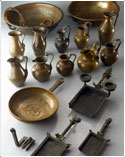

The Chalcolithic period, which dates between the fifth millennium and the first half of the fourth millennium, is divided into two chronological and cultural phases: the Early Chalcolithic (Pre-Ghassulian) that dates to the first half of the fifth millennium (c. 5000–4500 BCE) and the Late Chalcolithic (Ghassulian) dating to the second half of the fifth millennium and the first half of the fourth millennium (c. 4500–3500 BCE).
The period is characterized by rural settlements based on crop and livestock agriculture, introduction of new production technologies, strengthening of regional and interregional trade relations and cultural ties, and creation — for the first time — a complex and stratified society.
These gradual processes reach their peak during the Late Chalcolithic phase. The distribution of settlements, including habitation, cultic and burial sites intensifies and extends from the Negev and Judean Deserts in the south to the Golan Heights in the north. For the first time the production of ceramics takes on an industrial nature with the introduction of the potter’s wheel and improved firing techniques. Also for the first time, tools as well as fine ware and cult vessels were cast in copper. Some of these objects were produced using the “lost-wax technique”. Along with this specialized copper manufacture, basalt, bone, shell and ivory industries also flourished, producing items such as bowls, chalices, statues, figurines and pendants.
|







